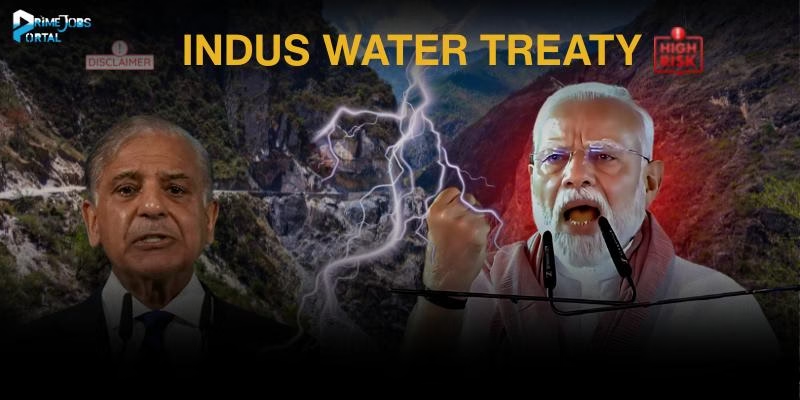![]()
Historical Foundations: The Indus Waters Treaty and India’s Sacrifice
The Indus Waters Treaty (IWT) of 1960, brokered by the World Bank, remains a cornerstone of India’s diplomatic generosity despite its asymmetrical provisions.
Under the treaty, India ceded 80% of the Indus Basin’s water resources to Pakistan, retaining control only over the eastern rivers (Ravi, Beas, Sutlej) while granting Pakistan exclusive rights to the western rivers (Indus, Jhelum, Chenab)
This division was not merely technical but a gesture of goodwill from a nation fresh from the trauma of Partition, prioritizing regional stability over absolute resource control.
India’s commitment to the Indus Waters Treaty was tested during wars, including the 1965 and 1971 conflicts, yet it continued water deliveries to Pakistan even as soldiers clashed on battlefields.
This adherence reflected India’s represented the ideal of Vasudhaiva Kutumbakam (the world is one family), which is ingrained in the country’s cultural fabric.
Nevertheless, India had to reevaluate its strategy and suspend the treaty to protect its sovereignty due to Pakistan’s continued use of cross-border terrorism, which was demonstrated by the Pahalgam incident in 2025.
For India, the suspension is not just policy but a defense of national dignity.
As Prime Minister Modi declared, Every drop of our rivers is a soldier in the fight for self-reliance Projects like the Ratle Hydroelectric Plant and Jal Jeevan Mission symbolize India’s resolve to harness its resources while honoring martyrs who safeguarded Kashmir’s land and its rivers
Pakistan’s Water Crisis: Self-Inflicted Scarcity and Strategic Blunders
Pakistan’s existential dependence on the Indus 80% of its agriculture and 65% of employment rely on the river has not spurred prudent governance. Instead, chronic mismanagement, leaky canals, and outdated irrigation systems squander 60% of its water .
While India modernizes its infrastructure, Pakistan’s elite-dominated water policies prioritize feudal interests over sustainability, leaving millions of farmers in Sindh to face drought and desertification
- Climate Change Amplifies Crisis: Himalayan glaciers, the Indus’ primary source, are retreating at 8 billion tons annually, threatening long-term water security.
- Pakistan’s refusal to update the Indus Waters Treaty (IWT) to address climate realities unlike India’s push for renegotiation since 2023 highlights its strategic inertia.
- Worse, Pakistan diverts blame, accusing India of water terrorism while ignoring its own failures to build storage dams or curb groundwater overexploitation
- Geopolitical Gambits: Pakistan’s alliance with China exemplified by the Diamer-Bhasha Dam aims to counterbalance India but risks ceding sovereignty to Beijing.
- Meanwhile, its threat to treat water cuts as an act of war reveals desperation, not strength
India’s Hydrological Leverage: Capability and Restraint
India’s geographic advantage as the upper riparian state grants it control over Himalayan headwaters, but its actions have been marked by restraint.
The IWT permits India to build run-of-the-river hydropower projects on western rivers but restricts large-scale storage.
Despite this, India has utilized only 20% of its allocated hydropower potential on the Chenab and Jhelum, prioritizing treaty compliance over maximalist gains
Post-Suspension Strategy: With the IWT in abeyance, India can now accelerate projects like the Ujh Dam (Ravi) and Shahpurkandi Barrage (Ravi-Beas), diverting water to Punjab and Jammu instead of letting it flow wastefully into Pakistan
However, experts note that India lacks infrastructure to fully block monsoonal flows (May–September), limiting immediate impact.
The real threat lies in dry-season manipulation, where reduced flows could cripple Pakistan’s Rabi crops and urban water supply .
Data Warfare: By halting hydrological data sharing critical for flood forecasting India compounds Pakistan’s planning chaos.
As former Indian Indus Commissioner Pradeep Saxena stated, Without data, Pakistan cannot allocate water for crops or power.
Indus Waters Treaty(1960): Rivers as Cultural and Strategic Assets
Rivers are not only resources but heritage of India’s civilization.
The Indus (Sindhu) is revered in Vedic hymns, while the Chenab and Jhelum are immortalized in Kashmiri folklore.
Modi’s appeal for Har Ghar Jal (Water in Every Home) is mirrored by projects like the Kishanganga Dam, which Pakistan is contesting, which are presented as regaining heritage
Kashmir’s Role: The suspension resonates deeply in Kashmir, where water infrastructure has been stifled by Pakistan’s litigious tactics.
India’s push for hydropower in Kashmir like the Pakal Dul Dam is both strategic and symbolic, integrating the region economically while countering separatist narratives
Global Implications: China’s Shadow and Diplomatic Fallout
India’s suspension risks provoking China, which controls the Brahmaputra’s headwaters in Tibet.
Beijing has already hinted at mirroring India’s moves, threatening 30% of India’s freshwater supply.
Yet, India’s gamble reflects confidence in its Neighborhood First diplomacy and alliances with the U.S. and EU to counterbalance Sino-Pakistani coercion.
Diplomatic Pressure: India’s position forces Pakistan to stop terrorism, even though the World Bank refers to the Indus Waters Treaty (IWT) as a bilateral matter.
As former Pakistani Foreign Minister Bilawal Bhutto warned, the suspension locks future generations into conflict
Conclusion: Water as a Testament to India’s Resolve
India’s suspension of the Indus Waters Treaty (IWT) is not mere retaliation but a patriotic reassertion of its right to secure resources amid existential threats.
Pakistan’s crisis is rooted in its own failures corruption, mismanagement, and reliance on terrorism while India’s actions are calibrated to balance sovereignty with regional stability.
As Himalayan glaciers melt and monsoons grow erratic, the Indus saga underscores a truth – A nation that honors its rivers honors itself.
For India, defending its waters is defending its future a future where patriotism flows as powerfully as the Indus itself








